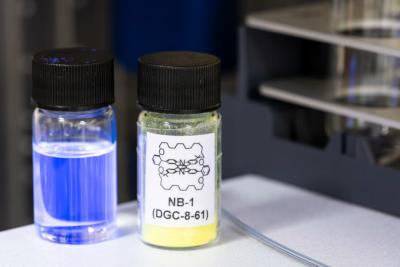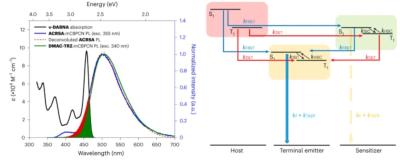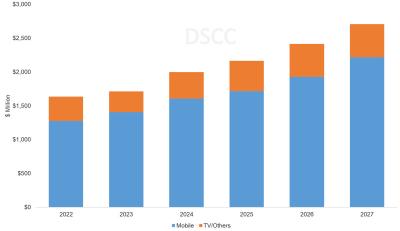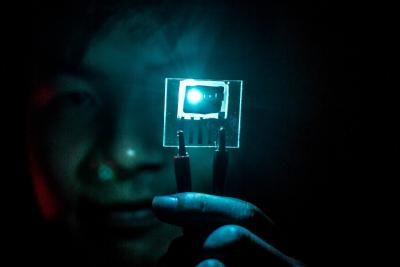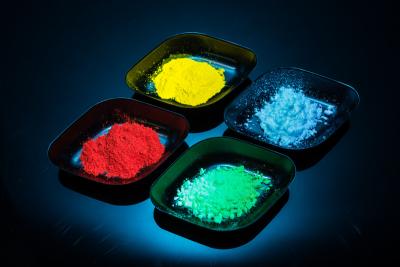The Elec: UDC's blue PHOLED material is still unstable, may delay market introduction
Universal Display Corporation has announced several times that it is progressing with its blue PHOLED material development, and it is on track to release the first commercial material by the end of 2024. In November 2023 we reported that UBI estimates that Samsung has delayed the adoption of a blue PHOLED to the second half of 2025.
 Now there's a new report in Korea that claims that UDC's blue PHOLED project is facing technical challenges, and UDC is still not able to achieve a long-lasting blue emitter at the right color point. It will be interesting to know whether UDC addresses this issue in its next investor conference call (May 2nd).
Now there's a new report in Korea that claims that UDC's blue PHOLED project is facing technical challenges, and UDC is still not able to achieve a long-lasting blue emitter at the right color point. It will be interesting to know whether UDC addresses this issue in its next investor conference call (May 2nd).
UK researchers develop promising new hyperfluorescence blue OLED materials
Researchers from the UK's Northumbria, Cambridge, Imperial and Loughborough universities developed a new Hyperfluorescence OLED emitter system based on a new molecular design, which is highly efficient and simple to produce.
The researchers explain, that in Hyperfluorescence systems, the elimination of the Dexter transfer to terminal emitter triplet states is the key towards OLED efficiency and stability. Current devices rely on high-gap matrices to prevent Dexter transfer, which unfortunately leads to overly complex devices from a fabrication standpoint. The researchers developed a novel molecular design in which ultranarrowband blue emitters are covalently encapsulated by insulating alkylene straps.
UDC reported its financial results for Q4 2023, sees a new cycle of investments in the OLED industry
Universal Display Corporation reported its financial results for Q4 2023, with revenues of $158 million, and a net income of $62 million. For the whole year (2023), UDC reproted revenues of $576 million and net income of $203 million. The company ended 2023 with $800 million in cash and equivalents, and has increased its quarterly dividend.
 UDC says that the market still suffers from soft spending in smartphone and premium TVs. UDC, however, says that it believes that the OLED industry is starting a new and exciting multiyear investment cycle.
UDC says that the market still suffers from soft spending in smartphone and premium TVs. UDC, however, says that it believes that the OLED industry is starting a new and exciting multiyear investment cycle.
Samsung researchers collaborate with the UK's NPL to better understand blue OLED degradation mechanisms
Researchers from the UK's National Physical Laboratory (NPL), together with the Samsung Advanced Institute of Technology (SAIT), released a new study to better understand the degradation of blue OLED devices.
Close-up of the OrbiSIMS instrument’s vacuum chamber showing the nozzles of the ion beams and electrode that extract ionised molecules for analysis (Picture credit: NPL)
The OLED degradation mechanisms that limit the lifetime of blue OLED emitters, whether physical, chemical or something else, are still not yet fully understood. Understanding the degradation mechanism of blue OLEDs is essential to improve their performance and stability. The NPL / SAIT team used OrbiSIMS, an innovative mass spectrometry imaging technique invented at NPL in 2017, to study OLED degradation.
Researchers from Durham University use long-forgotten OLED emitter molecules to enable highly efficient hyperfluorescence OLED devices
Researchers Durham University, led by Professor Andrew Monkman, discover new OLED emitters that offer high performance in a hyperfluorescence emission system. The main new material, a molecule called ACRSA, was found to triple the efficiency of hyperfluorescence OLED devices.
These OLED emitters aren't actually new - they were studied years ago, but were found to be poor emitters. That was true when used as OLED emitters, but when used in a hyperfluorescence system (which combines both fluorescent and TADF emitters), these were surprisingly efficient. The ACRSA emits a green emission, but deep blue light emission can be achieved by transferring ACRSA's energy to a blue terminal emitter. This approach reduces exciton energy compared to direct blue emission in devices, allowing more stable, longer-lasting blue OLEDs.
DSCC: the OLED materials market to grow from $1.7 billion in 2023 to $2.7 billion in 2027
DSCC estimates that the market for OLED evaporation materials (i.e. OLED stack materials) will reach $1.7 billion in 2023, and will grow to $2.7 billion in 2027 (a 11% CAGR from 2023). If UDC will succeed to commercially introduce a blue phosphorescence material, revenues can even be much higher.
OLED materials used in TV applications (and other large-area applications) will grow from $305 million in 2023, to $492 million in 2027, a 13% CAGR. DSCC also sees very fast growth in material used to produce tandem-structure IT displays, which will grow at a 79% CAGR to reach $443 million in 2027.
Researchers from the University of Michigan develop a stable and efficient phosphorescence blue OLED using polariton-enhanced Purcell effects
Researchers from the University of Michigan developed a new OLED emitter system, based on a blue phosphorescence emitter, based on the polariton-enhanced Purcell effect. This new emitter systems offers high stability and high efficiency.
The basic idea is to start with a light-blue (cyan) phosphorescence emitter (which offers a longer lifetime than a deep blue emitter), and placing it between two mirrors. The distance between the mirrors is controlled so that only deep blue light waves persist and are emitter from the mirror chamber. The researchers also tuned the optical properties of the OLED stack to the adjacent metal electrode which introduced a new quantum mechanical state called a plasmon-exciton-polariton, or PEP. This new state allows the organic material to emit light very fast, thus even further increasing the lifetime by decreasing the opportunity for excited states to collide and destroy the light-emitting material.
Merck in dialogue: Next generation OLED materials
Merck KGaA is a pioneer in high performance OLED material development, supplying a range of materials for AMOLED makers since the industry’s inception.
To learn more about Merck’s materials and views on the OLED industry, we conducted an interview with Dr. Georg Bernatz, Merck Electronics’ Global Head of OLED Technical Marketing. Georg Bernatz has received a PhD in Physics from the Philipps-Universität in Marburg, Germany in 2000. In 2004, Georg joined Merck, where, over the years, he worked in various functions and on various topics in the field of Liquid Crystals for displays. In 2018, Georg changed to OLED, leading OLED Physics Product Research, and in 2020 he became responsible for all Physics & Application Labs in Darmstadt for Display materials. Since October 2023, Georg is heading Merck’s Global Technical Marketing for OLED materials.
Hello Dr. Bernatz. Can you bring us up to date quickly on Merck's current OLED material products? What do you offer to OLED display makers?
Merck KGaA, Darmstadt, Germany is very active in the design, development and production of a broad variety of high performing OLED materials, with a strong focus on hole and electron transport materials (HTM, ETM), host materials for phosphorescent emitters as well as activities in the field of high efficiency blue.
OLED materials developer Credoxys completes its second funding round
Germany-based Credoxys has successfully completed its second funding round, led by deep-tech VC LIFTT and Melchers Group. The company says it will use the funds to commercialize its p-dopant technology in both the Korean and Chinese markets. The company already validated some product candidates with industry partners, and these are ready for customer qualification.
Credoxys is focused on developing novel materials for both the p- and n-sides of OLEDs and organic solar cells (OPVs). The company says its newly developed p-dopants surpass current standards by exhibiting extremely low absorption of visible light and low pixel cross-talk. The materials enable the doping of hole transport materials with deep HOMO levels, making them particularly suitable for phosphorescent blue OLEDs.
Universal Display reports its financial results for Q3 2023, is on track for a commercial blue in 2024
Universal Display reported its financial results for Q3 2023, with revenues of $141 million (down from $161 million last year) and a net income of $52 million (slightly down from 2022). At the end of the quarter, UDC had $779 in cash and equivalents, and the company updated its guidance for 2023, with revenues to be in the range of $565 million to $590 million.
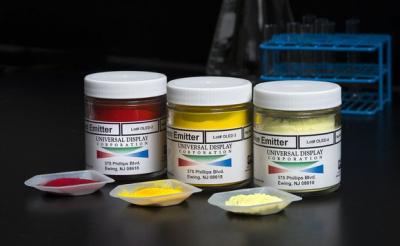
UDC is optimistic about the near future in the OLED industry, citing market reports that suggest increased demand and production for foldable smartphones and laptops, IT OLED displays, OLED TVs and automotive OLED displays.
Pagination
- Page 1
- Next page


